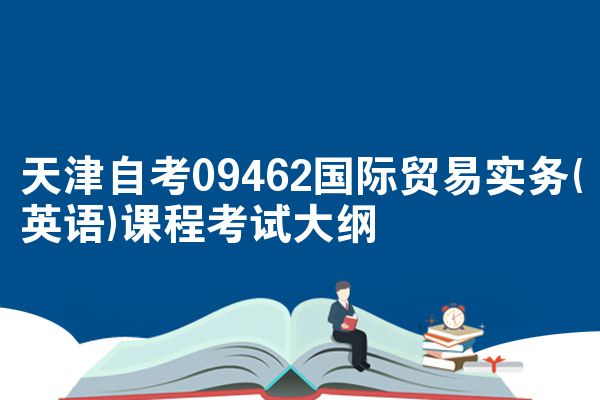
《自考视频辅导课程》轻松易懂,助你拿证!点击试听,综合优惠低至69元/科!
天津自考09462国际贸易实务(英语)课程考试大纲已公布,天津自学考试大纲09462国际贸易实务(英语)内容包括:09462国际贸易实务(英语)课程性质与目标、考核内容与考核目标、有关说明与实施要求等,详情见下文:

天津市高等教育自学考试课程考试大纲
课程名称:国际贸易实务(英语) 课程代码:09462
第一部分课程性质与目标
一、课程性质与特点
《国际贸易实务(英语)》是高等教育自学考试英语(专升本)专业的专业课程,它是一门理论联系实际,实用性很强的课程。本课程以国际贸易实务的环节为主线,系统介绍了国际贸易各环节的一般操作规则和国际惯例。全书用英文编写,力争让使用者在学习国际贸易实务相关知识的过程中掌握相关的英语表达方法,在学习国际贸易时读英语的过程中掌握国际贸易实务相关知识,力求帮助使用者培养用英语思维的习惯,以提高驾驭英语的能力。
二、课程目标与基本要求
本课程是一本应用性和操作性很强的课程,设置本课程,考生不仅可以掌握进出口贸易业务知识,同时还能学会如何用英语来表达具体的商务流程。通过本课程的学习,考生应熟悉进出口贸易的整个流程,掌握各环节的操作规程和国际惯例,并具备一定的用英语来进行实际表达和操作的能力。
第二部分考核内容与考核目标
Chapter 1 International Trade
学习目的和要求:了解国际贸易的定义及其产生的原因,方式,发展国际贸易的重要性及存在的问题。熟悉国际贸易的两个理论,即绝对利益和比较利益理论,以及关税壁垒、非关税壁垒等贸易限制措施。掌握相关专业词汇。
(一)reasons for international trade(重点)
识记:economic reasons
理解:resource reasons,political reasons
应用:the principles of absolute advantage and comparative advantage
(二)Problems in international trade(次重点)
识记:trade protectionism(tariffs,non-tariff barriers)
理解:cultural problems,monetary conversion
(三)benefits of international trade,arguments against international trade(一般)
Chapter 2 Terms of Delivery
学习目的和要求:掌握国际贸易中的交货条款,尤其是Incoterms 2000中的四大类术语解释(Group E terms,Group F terms,Group C terms,Group D terms,)。掌握相关专业词汇。
一.
二、考核知识点与考核目标
(一)overview of the structure of Incoterms 2000(重点)
识记:Group E terms,Group F terms,Group C terms,Group D terms,
理解:brief explanation of the Terms
应用:EXW,FCA,FAS,FOB,CFR,CIF,CPT,CIP,DAF,DES,DEQ,DDU,DDP
(二)considerations for choosing terms of delivery(次重点)
识记:transport capacity,customer’s location
理解:freight rate,loading/unloading facilities and local port custom,risks in transit
(三)vital aspects of a transaction,purpose of terms of delivery and Incoterms(一般)
Chapter 3 Cargo Packaging,Stowage&Marking
一、学习目的和要求:了解货物的包装、装载和标志。尤其了解商品包装的作用,类型,货物的标志类型。掌握相关专业词汇。
二、考核知识点与考核目标
(一)cargo packaging and marking(重点)
识记:types of packaging
理解:types of mark,marking requirement
应用:examples of the handling marks
(二)stowage of cargo(次重点)
识记:general principles
理解:considerations in the stowage of cargo
(三)needs of cargo packaging(一般)
识记:areas of improvement
理解:factors influencing types of cargo packaging
应用:packaging clause
Chapter 4 Transport
一、学习目的和要求:了解各种运输方式,包括海运、空运、铁路运输、集装箱运输等,以及货物运输的一般注意事项。掌握相关专业词汇。
二、考核知识点与考核目标
(一)ocean transport(重点)
识记:classification of merchant vessels,ocean B/L
理解:clause of shipment
应用:types of B/L
(二)other means of transport(次重点)
识记:air transport,rail transport,road transport,containerization,pipelines
理解:international multi-modal transport
(三)general considerations in cargo transport(一般)
Chapter 5 Foreign Exchange Rate and Contract Formation---Offer and Acceptance
一、学习目的和要求:了解外汇汇率,如何防止汇率的不利变动,合同成立中的发盘及接受。掌握相关专业词汇。
二、考核知识点与考核目标
(一)contract formation(重点)
识记:offer and acceptance
理解:definite offer,indefinite offer,requirements for an acceptance,
(二)Foreign Exchange Rate(次重点)
识记:foreign exchange
理解:quotation
应用:protection against adverse movement of exchange rate
(三)conditions of sale(一般)
Chapter 6 Payment Terms
一、学习目的和要求:了解付款条件,尤其是国际贸易中的支付工具(汇票、期票、支票)及各种支付方式(预付现金、跟单信用证、跟单托收、赊账)。掌握相关专业词汇。
二、考核知识点与考核目标
(一)methods of payment(重点)
识记:documentary letter of credit,documentary collection
理解:types of L/C,
应用:summary table of the four payment methods
(二)payment instruments of international trade(次重点)
识记:definition of draft,basic contents of draft,types of draft
理解:promissory note,check
应用:use of draft
(三)cash in advance,open account(一般)
Chapter 7 Ocean Marine Cargo Insurance
一、学习目的和要求:了解海运货物保险,尤其是海运货物保险的承保范围、基本原则、主要类别、保单转让、保费、货物保险索赔等。掌握相关专业词汇。
二、考核知识点与考核目标
(一)coverage,fundamental principles,and main categories of ocean marine cargo insurance(重点)
识记:FPA,WA/WPA,AR,ICC(A),ICC(B),ICC(C)
理解:choice of the right coverage
(二)major types and assignment of insurance policy,cargo insurance claims(次重点)
识记:time policy,voyage policy,mixed policy,floating policy,open policy
理解:guidelines and procedures of cargo insurance claims
应用:basic documents required to claim under a Marine Cargo Insurance Policy
(三)warranties,premium(一般)
Chapter 8 Inspection,Force Majeure and Private Dispute Resolution
一、学习目的和要求:了解商检、不可抗力及如何通过仲裁和调解妥善解决争端。掌握相关专业词汇。
二、考核知识点与考核目标
(一)commodity inspection(重点)
识记:place and time of inspection,inspection agency and certificate
理解:re-inspection
应用:methods and standards of inspection
(二)private dispute resolution(次重点)
识记:definition of arbitration and meditation
理解:arbitration case flow
应用:arbitration clause
(三)force majeure(一般)
识记:definition of force majeure
理解:consequences of force majeure
应用:sample force majeure clause
Chapter 9 Documentation
一、学习目的和要求:了解单证的作用及主要单证类型(进出口许可证、形式发票、商业发票、领事发票、海关发票、汇票、原产地证书、卫生证明、检验证书、货价证明、装箱清单、提单、码头收据、大副收据、航空运单、保单等)。掌握相关专业词汇。
二、考核知识点与考核目标
(一)major documents(重点)
识记:export license,import license,pro-forma invoice,commercial invoice,consular invoice,customs invoice,bill of exchange,certificate of origin,certificate of health/sanitary certificate,certificate of inspection,certificate of value,packing list/weight memo,bill of lading,dock receipt,mate’s receipt,air waybill,insurance policy/certificate
(二)role of documentation(次重点)
理解:the major purpose of documentation
Chapter 10 International Trade Procedures
一、学习目的和要求:了解国际贸易中进出口程序。掌握相关专业词汇。
二、考核知识点与考核目标
(一)the procedures of import(重点)
识记:different steps in an import transaction
理解:import controls,import contract,L/C issuance and amendment,shipment and insurance,document examination and payment,customs clearance,taking delivery and re-inspection,settlement of disputes
(二)the procedures of export(次重点)
识记:different steps in an export transaction
理解:pre-export work,export controls,export contract,pre-shipment and post-shipment finance,export credit insurance,preparation of goods,L/C,export declaration and customs clearance,shipment,insurance,documentation and payment
(三)managing international trade procedures(一般)
第三部分有关说明与实施要求
一、考核目标的能力层次表述
本课程的能力考核目标共分为三个能力层次:“识记”、“理解”、“应用”。各能力层次为递进等级关系,后者必须建立在前者的基础上,其含义是:
识记:能够识别和记忆本课程中的有关名词、概念及规律的主要内容,并能够根据考核的不同要求,做出正确的表述、选择和判断。
理解:能够领悟和理解本课程中有关概念及规律的内涵,全面把握基本概念、基本原理、基本方法,能掌握有关概念、原理、方法的区别与联系,并能够根据考核的不同要求,对问题进行逻辑推理和论证,做出正确的判断、解释和说明。
应用(包含简单应用和综合应用):能在理解掌握国际贸易实务的基本概念、文本结构、语言特点的基础上,联系实际,运用基本原理、基本方法,结合学过的相关知识点,分析解决理论问题和实际问题。
二、指定教材
指定教材为考生自学、社会助学和考试命题的依据。
指定教材:《国际贸易实务(第二版)》王沅沅主编高等教育出版社2009年2月
三、自学方法指导
1、自学时必须要认真阅读教材,开始阅读每一章之前,应先认真学习大纲中有关该章的考核知识点、自学要求以及对知识点的能力层次要求和考核要求。以便在阅读教材时做到心中有数,有的放矢。
2、使用教材时,应注意将精读与泛读相结合,应在泛读即通读的基础和掌握较全面的知识背景条件下,对考核知识点进行重点地逐段细读,逐句推敲,以求做到对基本概念深刻理解,对教材脉络彻底弄清,对基本理论牢固掌握。切忌在没有全面学习教材的情况下孤立地抓考核知识点,以免生吞活剥,不能真正地理解和灵活地运用。
3、在自学过程中,既要思考问题,也要做好阅读笔记,把教材中的基本概念术语、基本理论、基本方法加以整理,归纳出要点,从而加深对问题的认知、理解和记忆。有利于突出重点,并涵盖全部课程内容,同时锻炼提高自己的自学能力。
4、在自学过程中,既要注重理论知识,也应重视实际运用能力的培养。要通过完成练习思考题、撰写小论文,锻炼自己分析论证及书面表达的能力。完成书后作业和适当的辅导练习是理解、消化和巩固所学知识,培养分析问题、解决问题及提高能力的重要环节,在做练习之前,应认真阅读教材,按考核目标所要求的不同层次,掌握教材内容,在练习过程中对所学知识进行合理的回顾与发挥,注重理论联系实际和具体问题具体分析
四、对社会助学的要求
1.社会助学者应根据本大纲规定的考试内容和考核目标,认真钻研自学考试指定教材,明确本课程与其他课程不同的特点和学习要求,对自学应考者进行切实有效的辅导,引导他们防止自学中的各种偏向,把握社会助学的正确导向。
2.要正确处理基础知识和应用能力的关系,努力引导自学应考者将识记、理解与应用联系起来,把基础知识和理论转化为应用能力,在全面辅导的基础上,着重培养和提高自学应考者的分析问题和解决问题的能力。
3.要正确处理重点、次重点和一般的关系。课程内容有重点、次重点和一般之分,但考试内容是全面的,而且三者之间是相互联系的,不是截然分开的。社会助学者应指导自学应考者全面系统地学习教材,掌握全部考试内容和考核知识点,在此基础上再突出重点。总之,要把重点学习同兼顾一般结合起来,切勿孤立地抓重点,把自学应考者引向猜题押题。
4.助学学时建议。本课程共4学分,助学建议不少于72学时,课程学时分配见下表,考生也可参考该表安排自学时间。
章次 | 课程内容 | 助学学时 |
Chapter 1 | International Trade | 6 |
Chapter 2 | Terms of Delivery | 7 |
Chapter 3 | Cargo Packaging, Stowage and Marking | 8 |
Chapter 4 | Transport | 8 |
Chapter 5 | Foreign Exchange Rate and Contract Formation---Offer and Acceptance | 8 |
Chapter 6 | Payment Terms | 7 |
Chapter 7 | Ocean Marine Cargo Insurance | 7 |
Chapter 8 | Inspection, Force Majeure and Private Dispute Resolution | 7 |
Chapter 9 | Documentation | 7 |
Chapter 10 | International Trade Procedures | 7 |
总计 | 72 | |
五、关于命题考试的若干规定
1、本大纲各章所提到的内容和考核目标都是考试的内容。
2、试卷中对不同能力层次要求和试题所占的比例大致是:“识记”为30%,“理解”为30%,“应用”为40%。
3、试题难易程度要合理,可分为四档:易、较易、较难、难,这四档在每份试卷中所占比例依次约为2:3:3:2。
4、每份试卷中,各类考核点所占比例约为:重点占60%,次重点占30%,一般占10%。
5、试题题型一般分为:词语解释、判断对错、填空、问答题等。
6、考试采用闭卷笔试。考试时间为150分钟,采用百分制评分,60分为及格。
六、 题型示例(样题)
I.Explain the following terms. (30 points, 5 points for each)
1 import license
2 foreign exchange control
3 quota
II.Decide whether the following statements are True or False. (10 points, 2 points for each)
1 ( ) Incoterms deal with all aspects of a sales contract.
2 ( ) The exchange rate is very important to determine the final earnings of an exporter.
III . Fill in the missing words in the following paragraph. (10 points, 1 point for each)
Many large multinational firms with numerous manufacturing (1)____ all the world began their foreign operations by (2)___. As this stage became successful, they established (3)____ companies overseas to market their exports. Where the sales company was able to develop sufficiently large market, a plant to (4)______ imported parts was set up. Finally, the complete product was manufactured (5)_______. However, this sequence should not be construed as the only way to become involved in (6)____ markets. In some countries, conditions may require that a complete (7)____manufacturing plant be the means of initial (8)____. (9)____ firms today are employing all of these methods (10)____ to reach their worldwide markets.
IV.Answer the following questions. (50 points, 10 points for each)
1. What are the reasons for international trade? Do you have any other reasons in addition to what have been listed in the text?
2. What is the principle of comparative advantage?
文章来源:http://www.zhaokao.net/zxks/system/2024/03/04/030007033.shtml
全专业电子资料、题库、学位、网课
最高直省2344元
上千+科次精品网课
买网课即送全真模考题库
五千+科次教材资料
电子资料满三件9折
五千+科次在线题库
全真呈现历年考试试题